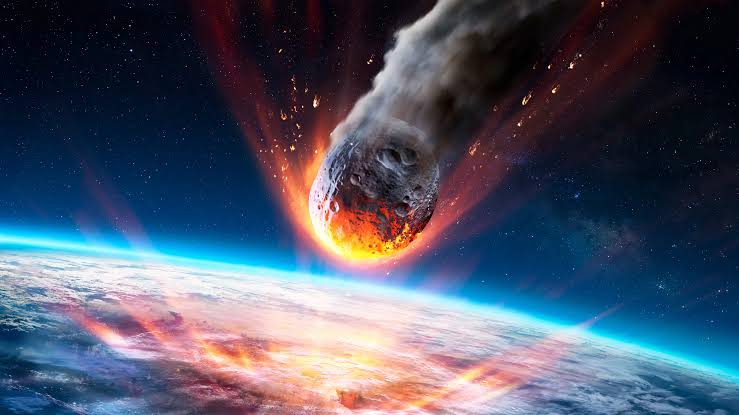In a discovery that’s caught the attention of both scientists and sky-watchers, experts are closely monitoring three large asteroids that may be heading toward Earth. While the chances of an actual collision are still being studied, early reports suggest that these space rocks are large enough to cause serious damage if they hit.
Scientists have labeled these objects as “city-killer” asteroids because they are big enough to wipe out an entire city if they strike the planet. Each of the three asteroids is estimated to be between 200 and 400 meters in size—comparable to a football stadium or taller than most skyscrapers. That’s more than enough to do serious damage, even if they landed in a less populated area.
These asteroids were detected by space agencies that constantly scan the skies for anything moving close to Earth. Using powerful telescopes and computer tracking systems, researchers noticed these three objects making their way through space on paths that could, in the worst-case scenario, bring them dangerously close to our planet in the coming weeks.
“This doesn’t mean we’re doomed,” said Dr. Anika Rao, an astronomer at the Global Space Observatory. “But it does mean we need to stay alert. The risk might be small, but the size of these objects means we can’t ignore them.”
According to Dr. Rao and her team, the three asteroids are currently several million kilometers away. That might sound like a lot—but in space terms, it’s close enough to keep scientists on edge, especially when the paths of these objects are still being studied and could shift slightly due to gravity from other celestial bodies.
“These rocks are traveling at tens of thousands of kilometers per hour,” Dr. Rao explained. “Even a small change in their path could make a big difference in where they go.”
The three asteroids have been named temporarily based on the dates they were discovered and coded using standard astronomical naming systems. For now, they’re being tracked carefully using radar and optical telescopes, and scientists are running simulations to predict where they’ll be in the days and weeks ahead.
While the public may be used to stories about near-Earth objects, what makes these particular asteroids stand out is their size and the timing. All three are expected to pass relatively close to Earth within the same month—a rare event. Most asteroids that pass by Earth are much smaller, often no larger than a car or a house. These ones, on the other hand, are massive enough to cause regional disasters.
“If even one of them were to hit land, it could cause an explosion as powerful as several nuclear bombs,” said Dr. Jordan Lee, a planetary defense expert. “It could flatten buildings, cause wildfires, and send shockwaves for miles. If it landed in the ocean, we could see massive tsunamis.”
Still, Dr. Lee and others stress that panic is not the answer. The chances of a direct hit are still very low, and global space agencies are working together to monitor the situation. The U.S. space agency NASA and the European Space Agency (ESA) have both released public updates and stated that they are continuing to collect data.
“These are the kinds of threats we’ve been preparing for,” said Dr. Lee. “We have teams running models day and night. We’re not in the dark here.”
In fact, this situation highlights the growing role of what’s called “planetary defense”—a field of science focused on spotting dangerous space objects and finding ways to deal with them. Recent missions like NASA’s DART project, which successfully tested how to change the path of an asteroid, have shown that humans are beginning to develop tools that could help one day prevent disaster.
“That test proved we can shift an asteroid’s path using a spacecraft,” said Dr. Rao. “If needed, future missions could be launched to deflect a dangerous object—if we catch it early enough.”
In the meantime, people around the world are curious—and some are nervous. Social media has been buzzing with discussions about what might happen if one of the asteroids does come too close. Some have even compared the situation to Hollywood movies like Armageddon or Don’t Look Up, which deal with asteroid threats in dramatic ways.
But scientists urge the public to stay calm and rely on trusted sources for updates. “This is not the time for panic or wild rumors,” said Dr. Lee. “It’s a time for careful science and good communication.”
For now, all three asteroids are expected to fly past Earth safely, but researchers are keeping a close watch just in case. They’re updating their tracking systems daily, checking for any changes in speed or direction. The good news is that space technology today is better than ever, allowing scientists to spot these threats earlier and more accurately than in the past.
The idea of a giant rock from space slamming into Earth is a scary one—but it’s also a reminder of how important it is to keep looking up. Just a few decades ago, humanity would have had no way of knowing these objects were coming. Today, thanks to science and international cooperation, we have eyes on the sky and plans in place.
“In many ways, this is a success story,” said Dr. Rao. “We’ve found them early, we’re tracking them, and we’re talking openly about what to do. That’s exactly what good science should do.”
In the coming weeks, scientists will continue to monitor the asteroids closely. Updates will be shared with the public as new data comes in. And while the threat remains low for now, the event has reminded us all of how powerful—and unpredictable—the universe can be.
Until then, the best thing for most people to do is stay informed, not scared. The odds are still in our favor, and the world’s top space experts are on the case.

